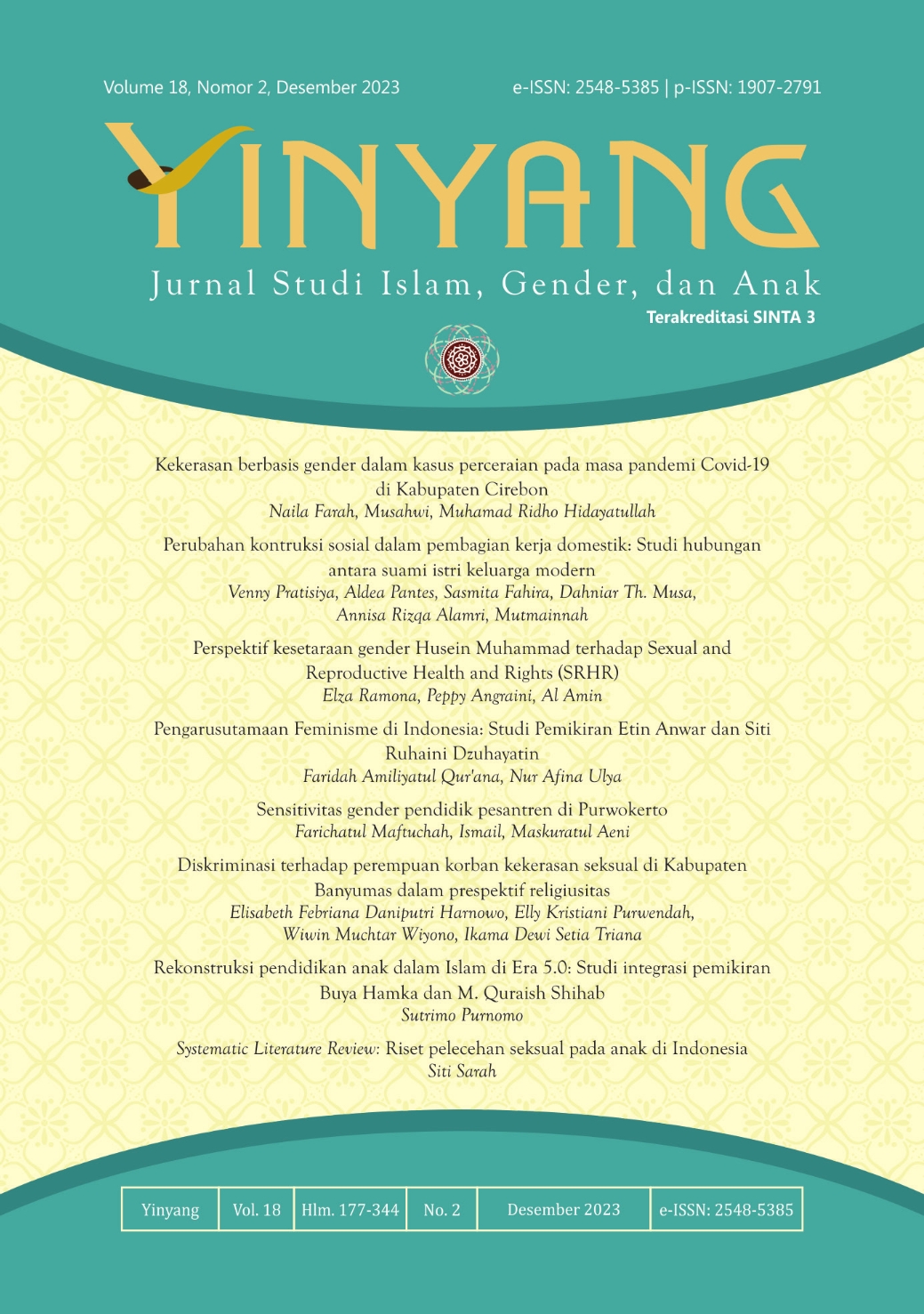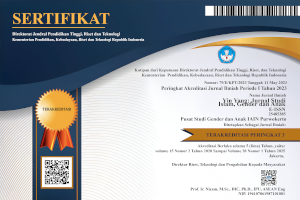Kekerasan berbasis gender dalam kasus perceraian pada masa pandemi Covid-19 di Kabupaten Cirebon
DOI:
https://doi.org/10.24090/yinyang.v18i2.9188Keywords:
Gender, Violance, Structural, Cultural, CirebonAbstract
Divorce cases during the Covid-19 Pandemic experienced a significant increase. In Cirebon Regency, an increase in the divorce rate was followed by many cases of violence against women in the family environment during the 2020-2023 Pandemic. This research seeks to understand the problem of gender-based violence in divorce cases and the various psycho-social implications arising from this condition for victims. In order to analyze the problem comprehensively, this study uses the framework of structural violence, cultural violence, and direct violence (physical and symbolic). Based on the results of the description and theoretical analysis, this study yielded findings including: (1) victims of violence were experienced by families with a weak economic basis, coming from poor families; (2) victims experience physical, psychological, sexual violence and neglect of the household; (3) the victim chooses a divorce to escape violence rather than asking for protection from women's protection services; (4) victims experience multiple psycho-social pressures after violence and divorce, namely: as victims of domestic violence, unemployment and economic instability, as well as the burden of raising children without the perpetrator's responsibilities as a father.Downloads
References
Awaliyah, Robiah dan Darmalaksana, Wahyudin. (2021). “Perceraian akibat dampak Covid-19 dalam Perspektif Hukum Islam dan Perundang-undangan di Indonesia”, Jurnal Khzanah Hukum, Vol. 3 No. 2.
Al-Munawar, Faishal Agil. (2020). “Telaah Fatwa tentang Nikah Siri”, Jurnal Ekonomi dan Hukum Islam, Vol. 4, No. 1, April.
Badan Pusat Statistik. (2022). Statistik Indonesia 2022. Jakarta: Badan Pusat Statistik/BPS.
Boxall, Hayley et.al. (2020). “The prevalence of domestic violence among women during the COVID-19 Pandemic”, Statistical Bulletin, Australian Institute of Criminology.
Confortini, Catia (2006). “Galtung, Violence, and Gender: The Case for a Peace Studies”, Feminism Alliance, Peace and Change: A Journal of Peace Research, Vol. 31, No. 3, July.
Eryanti, Linda Dwi. (2017). “Pemikiran Johan Galtung tentang Kekerasan dalam Perspektif Femisime”, Jurnal Hubungan Internasional, Vol. 6, No. 1.
Fadilah, Galbani dan Halim, Ilim Abdul. (2021). “Potensi Binadamai dalam Konflik dan Kekerasan di Srilanka Berdasarkan Pemikiran Johan Galtung”, Proceedings the 1st Confrence on Ushuluddin Studies, Gunung Djati Confrence Series, Volume 4.
Farid, Muhammad Rifa’at Adiakarti. (2020). “Kekerasan Terhadap Perempuan dalam Ketimpangan Relasi Kuasa: Studi Kasus di Rifka Annisa Women’s Crisis Center”, Jurnal Studi Gender, Vol. 14, No. 2.
Israpil. (2017). “Budaya Patriarki dan Kekerasan Terhadap Perempuan: Sejarah dan Perkembangannya”, Jurnal Pusaka, Vol. 5, No. 2.
Galistya, Theresia Mutiara. (2019). “Kekerasan Terhadap Perempuan dan Perceraian Dalam Persepktif Pemberdayaan Perempuan”, Jurnal Dinamika Sosial Budaya, Vol. 21, No. 1.
Gama, A. et.al. (2020). “Domestic Violence during the COVID-19 Pandemic in Portugal”, Portuguese Journal of Public Health, Vol. 38, No. 1.
Galtung, Johan. (1990). “Cultural Violance”, Journal of Peace, Vol .27, No. 3, http://www.jstor.org/stable/423472
Hasudungan, Peter et.al. (2020). “Work From Home dan Peningkatan Jumlah Kekerasan Terhadap Perempuan”, Paradigma: Jurnal Multidisipliner Mahasiswa Pascasarjana, Vol. 1 No. 1.
Hakim, Lukman Nul. (2013). “Ulasan Metologi Kualitatif: Wawancara Terhadap Elit”, Jurnal Aspirasi, Vol. 4, No. 2.
Katrina, Milaney. (2019). “The role of structural violence in family homelessness”, Canadian Journal of Public Health, Vol. 110, 554-562, doi: https://doi.org/10.17269/s41997-019-00219-y
Mas’udah, Siti et.al. (2021). “Women Resistance to Domistic Violence During Covid-19 Pandemic: A Study from Indonesia”, Jurnal Sosiologi Dialektika, Vol. 16, No. 2.
Maula, Bani Syarif; Ariyanti, Vivi. (2022). “Justice Negotiations for Women: Divorce Cases Due to Domestic Violence in Religious Courts”, Jurnal Hukum Islam, Vol. 20 No. 1.
Mohajan, Haradhan. (2018). “Qualitative Research Methodology in Social Sciences and Related Subjects”, Journal of Economic Development, Environment and People, Vol. 7, No. 1.
Muharram, Nur Ahmad. (2016). “Dampak di Balik Tindak kekerasan Terhadap Perempuan dan Anak Serta Solusinya”, Jurnal Harkat: Media Komunikasi Islam Tentang Gender dan Anak, Vol. 12, No. 2.
Narayan, Deepa, et.al. (2005). Measuring Empowerment: Cross Disciplanary Persepectives. Washington DC: The World Bank.
Perez-Vincent, Santiago M. (2020). Covid-19 Lockdowns and Domestic Violence: Evidence from Two Studies in Argentina. New York: Inter-American Development Bank.
Paramita, Astridia, dan Kristiana, Lusi. (2013). “Teknik Focuss Group Discussion Dalam Penelitian Kualitatif”, Buletin Penelitian Sistem Kesehatan, Vol. 16, No. 2.
Prawoto Nano, et.al. (2020). “The Impact of Covid-19 Pandemic on Sosio-Economic Mobility in Indonesia”, International Journal of Economics Business Administration, Vol. 13, No. 3.
Quiñones, Karen et.al. (2020). “Strategies for Territorial Peace: The Overcoming of the Structural Violence in Women Living in Palmira, Colombia”, Social Sciences, Vol. 9, No. 11.
Radhitya, Theresia Vania, et.al. (2020). “Dampak Pandemi Covid-19 Terhadap Kekerasan dalam Rumah Tangga”, Jurnal Kolaborasi Resolusi Konflik, Vol. 2, No. 2.
Rubin, Lilian. (1983). Intimate Strangers: Men and Women Together. New York: Haper & Row.
Sacco, Matteo Antonio, et.al. (2020). “The impact of the Covid-19 Pandemic on domestic violence: The dark side of home isolation during quarantine”, Medico-Legal Journal, Vol. 88, No. 2.
Shakouri, Nima. (2014). “Qualitative Research: Incredulity toward Metanarrativeness”, Journal of Education and Human Development, Vol. 3, No. 2.
Srivastava, et.al. (2017). “Structural Violence on Women: An Impediment to Women Empowerment”, Indian Journal Communitty Med., Vol. 42, No. 3.
Scott, James C. (2000). Senjatanya Orang-orang yang Kalah: Bentuk-bentuk Perlawanan Sehari-hari Kaum Tani, Jakarta: Yayasan Obor,.
Telles, Lisieux E. de Borba, et.al. (2020). “Domistic Violance in the Covid-19 Pandemic: A Forensic Psychiatric Perspective”, Barazilian Journal of Psychiatry (BJB), Vol. 43, No. 3, May-June, doi: http://dx.doi.org/10.1590/1516-4446-2020-1060
Umniyyah, Zahratul. (2021). “Kekerasan Berbasis Gender: Belenggu Patriarki Terhadap Perempuan dalam Novel Tempurung Karya Oka Rusmini”, Journal of Feminism dan Gender Studies, Vol. 1, No. 1.
Utami, Chyntia Paradivta, et al. (2021). “Peningkatan Kekerasan Terhadap Perempuan Dalam Lingkup Rumah Tangga Pada Masa Pandemi”, Journal of Politic and Policy, Vol. 3, No. 2.
Wahyuni dan Lestari Indri. (2018). “Bentuk Kekerasan dan Dampak Kekerasan Perempuan yang Tergambar dalam Novel Room Karya Emma Donoghue”, Jurnal Basa Taka Universitas Balikpapan, Vol. 1, No. 2.
Walby, Sylvia (ed). (1990). Theorizing Patriarchy. Oxford: Blackwell.
Downloads
Published
How to Cite
Issue
Section
License
Copyright (c) 2023 Naila Farah, Musahwi Musahwi, Muhamad Ridho Hidayatullah

This work is licensed under a Creative Commons Attribution-ShareAlike 4.0 International License.
Authors who publish with this journal agree to the following terms: Authors retain copyright and grant the journal right of first publication with the work simultaneously licensed under a Creative Commons Attribution-ShareAlike 4.0 International License that allows others to share the work with an acknowledgment of the work's authorship and initial publication in this journal.


















